We have now mostly identified the names on the town’s memorial and have tried where possible to provide details of their short lives. We now have the opportunity to find out what life was like in Wokingham in the late 1800’s and early 1900’s.
Local historian, Jim Bell joins Wokingham Remembers to provide a fascinating insight into a Wokingham life experienced by our servicemen before and after the wars. Following his article on the Nicholson family, Jim now tells the story of the cinema as seen by our residents of over the past 100 years.
Wokingham’s first cinema, Wokingham Picture Palace, opened on the afternoon of Monday, 10th March 1913 at No 10 Broad Street, in the days of the silent black and white films. Before the official opening three articles appeared in the Reading Mercury.
Saturday, February 1st 1913 – ‘Wokingham Picture Palace. An advertisement gives notice that this place of entertainment will be opened on or about the 26th inst. And that application should be made on or before that date for the 600 20 percent participating preference shares that remain to be allotted’.
Saturday, 1st March 1913 – ‘The Wokingham Picture Palace will be formally opened on Tuesday afternoon next and invitations have been sent to the leading residents of the district. A charge will be made for admissions and a share of the proceeds will be given to the Crowthorne & District Nursing Association. The Directors will provide light refreshments. The first public performance will take place the same evening’.
Saturday, 15th March 1913 – ‘Electric Theatre. The opening of this place of amusement took place on Monday afternoon. The Mayor (Councillor W. T. Martin) opened the proceedings and switched on the first film. Mr. Vince, a director, thanked the Mayor for his kindness. A selection of films was then exhibited. The theatre was filled at the evening performance’.
The cinema made a small contribution to the war effort of the First World War in 1914. Reading Mercury:
‘Saturday, October 24th 1914 – The Wokingham Picture Palace. ‘A matinee was given at the above theatre on Tuesday in aid of the Belgian refugees. The well-known bass, Mr. Berry, sang “The Battle Hymn” assisted by a chorus, and later the “Bugle Call”. The directors have much pleasure in handing over £5 to the fund.’
The Wokingham Picture Palace building is largely unchanged and stands on the site of the premises of Stevens Reuben basket makers and is now occupied by Nationwide. A little imagination on the part of the viewer will reveal the outline of cinemas of yester years. The building to the right, while similar in style, was not a part of the cinema and was actually built several years later.
Affectionately referred to as ‘The Bug House’, The Palace was very popular with children who would queue up on Saturday afternoons to see their favourite Laurel and Hardy or cowboy film. Admission to the front rows was threepence; middle rows: sixpence and back rows one shilling and threepence. In the 1920’s one of the ladies in the box office, although almost blind, was able to identify the coins by touch and seldom made mistakes. One of the commissionaires was a Mr. Horace Blake veteran soldier who sported a waxed moustache with twirled ends. He would stand outside briskly walking up and down in front of the cinema controlling the customers.
During the days of silent films, music was used to increase the drama of the film scenes. At one time it was supplied by a violinist and pianist. Two of the earlier musicians were Mr. Otley, violinist, and Miss Adey, pianist, who was succeeded by Dorothy Blake. According to Edna Goatley, Miss Adey was a music teacher and, when she wasn’t giving Edna and Ken lessons, she would play some of the sequences from the films.
The walls of the auditorium were decorated with jungles scenes and monkeys, painted by Dick Giles, a local signwriter. During the years when one could reserve a seat, some cinema goers would ask for seats beside the monkey as they provided a better view of the screen.
To the right of the screen was a door which led to the toilets. It also led to an exit so it was quite easy for the children to go home for tea and return unseen for a second viewing without having to pay.
1937: The Union Cinemas Ritz Opens
The prestigious “Union Cinemas Ritz” opened in Easthampstead Road in May 1937 and, for a number of years it competed with the humble Savoy, also owned by Union Cinemas. With the introduction of television at the beginning of the 1950s, cinema audiences began to decline and the Savoy now owned by a Mr. Handford, was the first casualty. When the Savoy gave its final show, The Champion, on the evening of Saturday, January 6th 1951, the reasons, given by Mr. Handford were the high rate of entertainment tax and the impossibility of complying with the quota regulations that stated that 30% of the films shown had to be British. The building was later sold and became the premises of Courtney Reed Ltd.—house furnishers.
The Ritz cinema in Easthampstead Road was officially opened on Saturday the 29th of May 1937. It was one of the most modern cinemas of its time as the description in the following article from the Reading Mercury will illustrate.
Saturday 29th May 1937– ‘Today (Saturday) the “Union Cinemas Ritz” will be opened to the public and the Mayor of Wokingham, Alderman F.J. Barrett J.P. will preside at the opening ceremony, which will take place at 2.30pm. Union Cinemas have set a unique standard in the furnishing and equipping of their theatres, incorporating the most modern ideas in design, combined with ideal comfort for patrons. The new “Union Cinemas Ritz,” Wokingham has been erected and equipped under the direction of Mr. J.H. Lundy of Union Cinemas Ritz, Wokingham the architect being Eric F. Tully L.R.L.B.A. the company’s staff architect. The new cinema is the most imposing building and occupies a commanding position a short distance down Easthampstead Road after turning out of Peach Street, the main thoroughfare of Wokingham. It affords a new car park with separate entrance and exit doorways and an exit into Denton Road for pedestrians. The main elevation to Easthampstead Road is carried out in red sand-faced bricks with stone dressings and is of light modern design. The entrance doors are featured on the corner facing towards the main street and are surmounted by a broad canopy, lighted on the underside by Neon tube lighting, whilst the opposite corner runs upwards in the form of an imposing tower and is in turn featured by tall projecting vanes to the front and side. These vanes serve the purpose of displaying the theatre name and are picked out in Neon lighting. The auditorium seats are all set radially thus affording a perfect vision of the screen from all positions and are served by gangways of generous proportions leading to exits at the front and rear. The interior scheme is in a light
decorative trend and much use has been made of Spray texture on which the varying tones of colour give a very pleasing effect, whilst leading the vision to the main decorative feature on the anti-proscenium walls. Excellent effect has been given by the two ornate grills set on either side of a large vertical cove, draped with silk and satin materials and artistically lighted. The main auditorium lighting is by means of chandeliers of exceptional beauty and decorative dome lighting far in advance of the usual type of lighting schemes usually associated with the modern cinema. Altogether, the new “Union Cinemas Ritz,” Wokingham regarded in detail or as a homogeneous whole must take its place as an important, as well as an imposing structure in the architecture of modern entertainment. In the projection department many thousands of pounds have been spent on the finest equipment obtainable. The famous B.T.H. Sound Reproducing apparatus has been installed together with the latest high intensity arcs and powerful modern projectors. Electricity is called upon to serve patrons from the moment it delivers tickets at the paybox. It lights warms and ventilates the building; works the clocks; operates the curtains; projects the films; reproduces the sound—and a hundred and one other details. The wonderful air conditioning plant which has been installed is another of the most important features in the “Union Cinema Ritz”. It literally manufactures weather conditions, for, by its means, the air is washed as it enters the building and every patron is served with a specific quantity of purified air, warmed or cooled to suit varying external conditions. When it is hot outside the building the patrons will find it beautifully cool inside and on the other hand when it is freezing outside the auditorium will be comfortable, warm and cosy.
It is gratifying to know that the new “Union Cinemas Ritz” has been built by local labour and local materials have been used as far as ever possible. The finishing touches are now being put to the new Union Cinemas Ritz, Wokingham, which will be opened to the public today (Saturday), at 2.30 pm and the programme that has been arranged for the opening ceremony and for the next week includes “Girls’ Dormitory,” starring Simone Simon. This film was especially selected to introduce Simone Simon to the screen, and she is surrounded by an impressive cast, which includes Herbert Marshall and Ruth Chatterton. “Girls Dormitory” is supported by “Three Married Men,” a sparkling, clever and true-to-life domestic comedy. Monday brings for three days, “This’ll Make You Whistle”. This gay musical film has proved Jack Buchanan’s greatest laughter maker.
The Ritz was proclaimed to be one of the finest in the south of England and the public was amazed and delighted to see the floor to ceiling mirrors that covered the walls of the foyer. There was also deep-pile carpeting, the seats were luxurious and dimming light was new. In the heat of a Saturday afternoon there was one place that was refreshingly cool—the Ritz cinema, Wokingham. The contrast between the temperature in the open and the Ritz left the impression that here was a cinema that was the acme in up-to-date comfort’.
The Ritz starts to crack.
Not long after the opening, however, the mirrors in the foyer began to crack. When buildings were being demolished to make room for the new cinema, older residents had warned the company about the suitability of the site. The problem was that Mr. William Denton had operated a chair manufacturing factory nearby and, over the years, sawdust had accumulated in the ground. The warnings were ignored and the sawdust, together with the natural composition of the soil, had resulted in instability. The mirrors were replaced with a more suitable wall covering.
Overview: A century of cinema-going
Going to the pictures in Britain in the early part of the 20th century was a very popular form of entertainment and by 1938, there were nearly 5,000 cinemas throughout the country. Going to the cinema or ‘the pictures’ was more than a night out. Courting couples and families often went to their local cinema twice a week to see their favourite stars and their local cinema was a ‘home from home’. Most cinemagoers had their favourite seats and, after buying tickets for the stalls or circle, they would queue up at the shop in the foyer for a bag of their favourite sweets or a packet of cigarettes. The frequent rustle of sweet wrappers and the haze of smoke during the performance were all a part of the evening out.
In the early years films, or ‘movies’, were silent and monochrome, or black and white. The ‘talkies’ were swiftly introduced in the late 1920s which brought about a significant increase in cinema audiences and this is generally accepted as being the start of the Golden Age of Hollywood. Meanwhile researches into animation and colour were in progress and, in 1937, cinema audiences were experiencing the wonder of Walt Disney’s first full-length film, Snow White and the Seven Dwarves. A year later came the excitement and glamour of The Adventures of Robin Hood starring the legendary Erroll Flynn.
Most cinemas gave continuous ‘double feature’ performances. For many it was their first introduction to luxury both in the cinema and on the silver screen itself. The former was lavishly decorated with curtains, mirrors, lighting and photographs of the stars while the latter revealed the envious lives of the upper classes either at home or in glamorous Hollywood where the sun shone continuously on fast cars, swimming pools or cowboys.
The doors usually opened early afternoon and the performance would commence with general advertisements followed by advertisements of films scheduled to be shown during the following week. These were known as ‘coming attractions’, or ‘trailers’. Then would come an interval during which members of the staff would enter the auditorium sell refreshments, mainly ice cream and fruit juice, which, for many years, stayed at sixpence or two and a half new pence. A Pathé film with the latest news would then be shown as there was no television in those days and, with luck, this was followed by a Disney cartoon. The ‘B film’ or low-budget film, usually a western, would come next and, after another interval, the audience would settle down to watch the ‘A’ film’ which was a more expensive production. Programmes were changed every three days (see advertisement opposite).
There was usually a full house and people came and went during the performance. If the film was a very popular one, queues would form and people would be allowed in when seats became available.
Advertising of future performances in the local newspaper was more detailed. Instead of merely providing the names of the films and actors, there was usually a resume of the films to be shown. The Reading Mercury, June 19th 1937, gives us an example:
‘Next week, until Wednesday, “Theodora Goes Wild” is being shown, featuring Irene Dunn and Melvyn Douglas. The ingenious plot concerns the adventures of Theodora Lynn (Irene Dunn), a small-town girl, who has written a highly successful novel. In order to keep the secret from her two aunts and her gossiping neighbours, she has written the book under an assumed name. She meets the artist who illustrated her book and he advises her to rebel against the narrow-mindedness of her neighbourhood, descending upon the vicinity himself to force her to bring about the emancipation. With this accomplished she proceeds to pay back in kind. It is at this stage that Theodora really goes wild’.
During the early years, admission to the Wokingham Ritz in the afternoon was sixpence in the stalls and one shilling and sixpence in the balcony.
Chums’ Club. About three weeks after the Ritz opened the following announcement appeared in the Reading Mercury of June 19th 1937:
‘Last Saturday, close on 500 happy children were enrolled as members of the Union Cinemas Ritz, “Chums Club”. A glorious time was spent by the youngsters, a special programme being provided for them which included comedies, cartoons and cowboy films. The Union Cinemas Chums’ Club meets every Saturday morning at 10 am and membership and badges are free. The president of the club is Shirley Temple. Every week the youngsters will enjoy community singing, and prizes will be awarded for various competitions amongst them’.
Minors’ Monitors would read out newsletters, from the A.B.C.’s (Associated British Cinemas) head office, from the stage. Seat Monitors were in charge of a block of seats and their duty was to ensure that the other children behaved. The manager of the Wokingham Ritz took monitors to the Gorrick Woods from time to time for picnics and arranged visits to the projection room. Talent shows were held onstage from time to time and every year the Ritz was the venue for a series of events that culminated in the crowning of the Carnival Queen.
Union Cinemas were taken over by Associated British Cinemas (A.B.C.) in 1937 and they operated the Wokingham Ritz until it was sold to Star Cinemas in June 1969.
World War Two: Wokingham Ritz
Two years after the Ritz opened in 1937 war was declared and cinemas nationwide were closed. A notice displayed outside the Ritz cinema declared, CLOSED—by order of his majesty King Hitler and his Lunatics. The closure didn’t last long because by September 11th 1939, Maureen O’Hara appeared in My Irish Molly. At the end of hostilities the following statement was read out at the beginning of all performances for a week:
‘We, the Directors and Staff of Associated British Cinemas offer our sincere congratulations to General Eisenhower, Field Marshall Montgomery and all allied Naval, Military and Air Force Commanders on their brilliant victory. From our hearts we thank the members of the forces who did the job so gallantly. We further extend our grateful thanks to the men and women of Great Britain who so courageously withstood the blitzes and who worked in the workshops, the factories, the mines and on the land to make this victory possible’.
In addition to showing films, the Ritz was the scene of memorable events including ceremonies by the Mayor. He presented leather wallets of brown pigskin embossed with the crest of the borough and the recipient’s initials, to those ex-service men and women who were fortunate enough to survive the Second World War. A second presentation took place on Sunday October 27th 1946, when a further 228 wallets were presented. The presentations took place later than planned because earlier in the year the wallets, manufactured by the Home for Disabled Soldiers, were stolen.
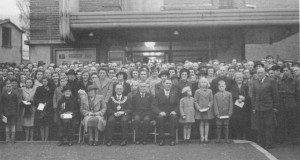
Presentation of wallets outside the Ritz cinema. (click on photo to increase size). Courtesy of Grahame Smith
The Wokingham Times & Weekly News reported—
‘An impressive and poignant moment was when the entire audience rose to its feet during the playing of two verses of Abide With Me and remained standing while the relatives of those who did not return and who had intimated their desire to be present received the posthumous presentation of the inscribed wallets from the Mayor. By this natural and thoughtful gesture the thoughts of everyone in that packed building went out to those proud parents and wives in their tragic loss. Alderman Perkins who called out the names of the recipients pointed out that among them were several high-ranking officers and also a number of men who had been decorated—but this occasion was such that it was more fitting if the men be called by their Christian and surnames—omitting rank and distinctions. To judge from the audience’s reaction this decision was a popular one’.
Post War Ritz
More recently all public places of entertainment were closed on Good Friday. In Wokingham congregations from local churches and their choirs went to the cinema for a joint service.
As with all cinemas the Ritz employed a commissionaire, one of whom was Mr. Blake, who ensured that the waiting crowds didn’t misbehave. In his smart uniform, waxed moustache and ramrod-straight back he was a magnificent figure.
The Ritz then passed to Jora Leisure Ltd. an independent operator, on November 1st 1977 who converted the main auditorium into a bingo hall and used 180 cinema seats in the circle area on occasions when films were shown.
The Ritz went over to full time bingo from November 10th 1979 and, in 1981, an extension was built onto the front of the main building to house a small cinema. The former circle was partitioned off to create a second screen seating for 190. One of the screens closed in August 1990 because of falling audiences. Audiences continued to drop and the death knell was sounded when an announcement was made stating that The Point, a new 10-big screen complex at Skimped Hill in Bracknell, was due to open in April of the following year. Jora Leisure hoped for an upturn in audience numbers and kept the Ritz open over Christmas, but on Thursday, January 10th, the curtain came down for the last time. The film shown was entitled, Ghosts, and although many had protested against the closing of the dear old Ritz only fifty people turned up. The sad demise of the Ritz, which had once been a household word, had gone almost unnoticed. In keeping with other cinemas it was a victim of progress and the recession.
Bingo continues in the Ritz, operated by Gala, but the building has been stripped of all its original internal and externally features. Nothing of it’s former opulence has been preserved.
| Approx | Proprietors | Name |
| 1910-32 | Wokingham Picture Palace | Wokingham Picture Palace Ltd |
| 1932-34 | Electric Theatre | D.W. & R. T. Hayward |
| 1935-36 | Savoy Electric Theatre | Basingham Electric Theatres Ltd |
| 1939 | Savoy Theatre | ditto |
| 1941 | Savoy Cinema | Union Cinemas Ltd (part of A.B.C. Cinemas) |
| 1950-51 | Savoy | Handford |
Table shows Cinemas in Wokingham 1910 – 1951

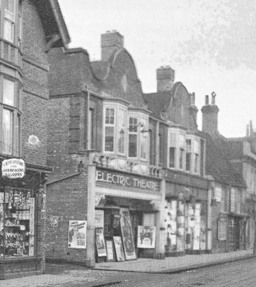
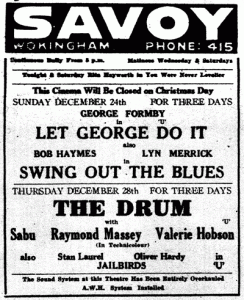
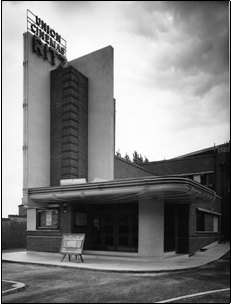
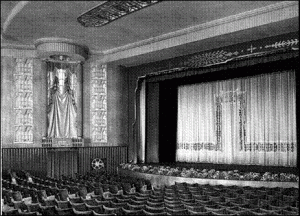
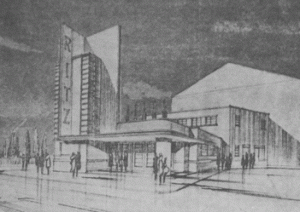
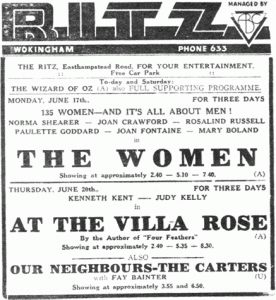
My mother Doris Aitchison (nee Hawkins) worked in the Wokingham Cinema for some years during the late 1940’s into the mid 1950’s, starting out as an usherette and eventually doing cashier and office work. She also worked in the Bracknell cinema
Hello Amanda, we are grateful to you for sharing this story. I hope you found the article of interest.
I was so pleased to read this article. My late father was the manager of Courtney Reed Carpet store at 10 Broad street in the late 1970s, and as a young lad I would help him on a Saturday. When Courtney Reed decided to close the store, my father had the rear half as his own carpet shop, Michael Orton carpets until about 1981 I believe. The front half was bought by the London and South of England building society, later the Nationwide. There was a hardware store next door called E.Hole run by a guy called Bernard, and a newsagents run by a Mrs Wheeler. Happy days indeed.
I worked at Courtney Reed in 1957 to 1958 when I joined the RAF. William (Bill) Brady was the manager, Audry Dowling cashier and secretary and Joe Merrick the van driver. I had passed my driving test whilst at the firm and on Wednesdays Joe’s day off, I drove the Bedford Luton van to the Slough branch and did their deliveries there. I enjoyed that year.
Dear Philip thanks very much indeed for your comment regarding Courtney Reed ( For Carpets lol) as the sign always said!
Your time would’ve been some 20 years before my father who had managed the Basingstoke branch before being sent to Wokingham.
His Area Manager was a guy named Tom Bailey, and his office secretary Daphne Royal, came with him when he bought the store from Courtney Reed when they pulled out of Wokingham.
There was an old man who would often call in and chat away to my father and I. My father said ( that he said) he was Will Hays son and was called Stan.
As an adult I googled Will Hay and no such child seems to have existed lol.
All good fun.
I have just come across your article on the RITZ cinema in East Hampstead Road
I was the last manager/projectionist from 1986 until closure.
I used to also live on the premises in the original projection box suite that had been converted into a flat
I had a dog with me that I called “RITZI”, and also had a fairground organ !
Many happy memories of running the cinema and of Wokingham
I am still in the business to this day.
Hello Barrie, what a fascinating contribution! The wurlitzer component is another angle altogether and introduces the musical hall theme which is a very significant part of our British heritage. Thank you.